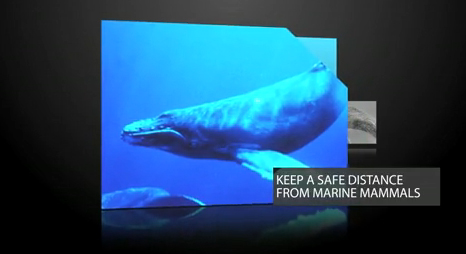Public Reminded to Keep Safe Distance From Whales
By Maui Now Staff
The US Coast Guard issued a reminder today of federal regulations that prohibit coming within 100 yards of whales when on the water, and 1,000 feet of them when operating an aircraft.
The reminder comes as humpback whales enter the peak season in their annual return to the Hawaiian Islands.
An estimated 10,000 humpbacks are expected to migrate to the islands this year to calve and nurse their young, according to the Hawaiian Islands Humpback Whale National Marine Sanctuary.
Officials say the season traditionally runs from November to May, with peak activity reported between January and March.
With several whale collisions near the Hawaiian Islands reported each year, the Coast Guard reminds boaters to slow down when whales are known to be in the area, and maintain a sharp lookout for whales at all times.
“Weighing an average of 45 tons, a humpback whale collision with a mariner can be catastrophic,” Coast Guard officials said in an agency press release.
Coast Guard crews will alert nearby mariners of whale activity to ensure the safety of the animals if they are observed during routine boat and air patrols.
The Coast Guard is among the agencies that also assist with marine mammal distress calls, and act as first responders to entanglements.
The public can report injured or entangled marine mammals to the Coast Guard on VHF marine channel 16, via phone at (808) 842-2600, or by contacting the Marine Mammal Stranding and Entanglement hotline at (888) 256-9840. Mariners can also report sightings by calling the local police.
“Prompt reporting is the best way to help distressed animals,” Coast Guard officials said.
Other partnering government agencies working in coordination to protect humpback whales include the National Oceanic and Atmospheric Administration, and the State of Hawaiʻi Division of Conservation and Resource Enforcement.
The following are tips that were published in the past by the Pacific Whale Foundation for vessel operators and ocean-goers to aid in the protection of marine mammals:
Being Whale Aware:
- LOOK OUT, WHEN WHALES ARE ABOUT: From December through May always stay at your helm and post an observer to spot whales while underway.
- SLOW DOWN, WHALES AROUND: From December through May reduce speed to 15 knots or less in ‘whale waters’ (waters 100 fathoms – 600 feet – in depth or less). Reduce speeds to 10 knots or less after dark.
- SEE A BLOW, GO EXTRA SLOW: Reduce your speed to 6 knots or less when within 440 yards of a whale or dolphin group. Avoid abrupt course changes.
- BRAKE FOR WHALES, STOP YOUR PROP: federal and state laws prohibit approaching humpback whales closer than 100 yards.
- 100 YARDS OR LESS = STOP: If your vessel unexpectedly encounters a humpback whale within 100 yards, STOP IMMEDIATELY and allow the whales to pass.
- AVOID APPROACHING whales and dolphins from the front or from directly behind. Always approach and depart from the side rear, moving in a direction parallel to the direction of the whales.
- KEEP CLEAR of the whales’ path. Avoid positioning your vessel within 440 yards of the path of traveling whales.
- BE CAUTIOUS and COURTEOUS: approach areas of known or suspected whale and dolphin activity with extreme caution. Look in all directions before planning your approach or departure.
- LIMIT YOUR VIEWING with whale groups containing calves to 30 minutes. This will minimize the cumulative impact of many vessels and give consideration to other viewers.
- NO MORE THAN THREE: Never more than three vessels of any size or type should stop to watch a whale or dolphin group.
- DO NOT SWIM with or FEED whales.
- If a COLLISION OCCURS, immediately call the National Marine Fisheries Service Marine Mammal Stranding Hotline: 1-888-256-9840. To report a violation of the 100-yard approach rule, or human related disturbance, call NOAA Enforcement: 1-800-853-1964.
Proper Whale Approach
- Vessels should operate in a direction parallel and to the side rear of the whale’s travel direction, maintaining a minimum distance of 100 yards.
- A vessel’s speed should be six knots or less and never faster than the whale’s speed when engaged in parallel viewing. When disengaging, angle vessel away from the nearest whale, and depart at slow, no-wake speed.
- Do not leap-frog ahead or cut in front of a whale’s path.











